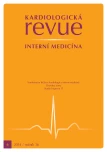Improve IT will change guidelines
Authors:
J. Špinar 1,2; L. Špinarová 3; J. Vítovec 3
Authors‘ workplace:
Interní kardiologická klinika LF MU a FN Brno
1; Mezinárodní centrum klinického výzkumu, FN u sv. Anny v Brně
2; I. interní kardioangiologická klinika LF MU a FN u sv. Anny v Brně
3
Published in:
Kardiol Rev Int Med 2014, 16(6): 489-492
Category:
Cardiology Review
Overview
Background:
The IMProved Reduction of Outcomes: Vytorin Efficacy Inter ‑ national Trial (IMPROVE ‑ IT) study is evaluating the potential benefit for reduction in major cardiovascular (CV) events of the addition of ezetimibe versus placebo to 40 mg/ d of simvastatin therapy in patients who present with acute coronary syndromes and have low ‑ density lipoprotein cholesterol (LDL‑C) ≤ 125 mg/ dL.
Methods:
The primary composite end point was CV death, nonfatal myocardial infarction (MI), nonfatal stroke, re‑hospitalization for unstable angina (UA), and coronary revascularization (≥ 30 days postran ‑ domization). The simvastatin monotherapy arm's LDL‑C target was < 70 mg/ dL. Ezetimibe was assumed to further lower LDL‑C by 15 mg/ dL and produce an estimated ~8% to 9% treatment effect. The targeted number of events was 5,250.
Results:
18,144 patients were enrolled with either ST‑segment elevation MI (STEMI, n = 5,192) or UA/ non‑ST‑segment elevation MI (UA/ NSTEMI, n = 12,952) from October 2005 to July 2010. Western Europe (40%) and North America (38%) were the leading enrolling regions. The STEMI cohort was younger and had a higher percentage of patients naive to lipid ‑ lowering treatment compared to the UA/ NSTEMI cohort. The UA/ NSTEMI group had a higher prevalence of diabetes, hypertension, and prior MI. Median LDL‑C at entry was 100 mg/ dL for STEMI and 93 mg/ dL for UA/ NSTEMI patients. Primary endpoint occurred in 2,742 patients (34.7%) treated with simvastatin in monotherapy and in 2,572 patients (32.7%) (p = 0,016) treated with combination treatment. To avoid one primary outcome, treatment of 50 patients for seven years was necessary.
Conclusions:
The study has shown a clear benefit from combination treatment with simvas ‑ tatin and ezetimibe in patients with acute coronary syndrome and low LDL‑C.
Keywords:
simvastatin – ezetimibe – cholesterol – acute coronary syndrome
Sources
1. Nakajima N, Miyauchi K, Yokoyama T et al. Effect of combination of ezetimibe and a statin on coronary plaque regression in patients with acute coronary syndrome ZEUS trial (eZEtimibe Ultrasound Study). IJC Metabolic and Endocrine 2014; 3 : 8 – 13. doi: 10.1016/ j.ijcme.2014.03.001.
2. Cannon CP, Giugliano RP, Blazing MA et al. Rationale and design of IMPROVE ‑ IT (IMProved Reduction of Outcomes: Vytorin Efficacy International Trial): comparison of ezetimbe/ simvastatin versus simva ‑ statin monotherapy on cardiovascular outcomes in patients with acute coronary syndromes. Am Heart J 2008; 156 : 826 – 832. doi: 10.1016/ j.ahj.2008.07.023.
3. Califf RM, Lokhnygina Y, Cannon CP et al. An up-date on the IMPro‑ved reduction of outcomes: Vytorin Efficacy International Trial (IMPROVE ‑ IT) design. Am Heart J 2010; 159 : 705 – 709. doi: 10.1016/ j.ahj.2010.03.004.
4. Laufs U, Descamps OS, Catapano AL et al. Understanding IMPROVE ‑ IT and the cardinal role of LDL‑C lowering in CVD prevention. Eur Heart J 2014; 35 : 1996 – 2000. doi: 10.1093/ eurheartj/ ehu228.
5. Blazing MA, Giugliano RP, Cannon CP et al. Evaluating cardiovascu lar event reduction with ezetimibe as an adjunct to simvastatin in 18,144 patients after acute coronary syndromes: final baseline charac ‑ teristics of the IMPROVE ‑ IT study population. Am Heart J 2014; 168 : 205 – 212. doi: 10.1016/ j.ahj.2014.05.004.
Labels
Paediatric cardiology Internal medicine Cardiac surgery CardiologyArticle was published in
Cardiology Review

2014 Issue 6
Most read in this issue
- Aortic diseases – diagnosis, classification and management principles
- Combination of anticoagulant and antiaggregant treatment in patients after myocardial infarction with an indication for anticoagulant treatment – so‑ called triple therapy
- Triple-combination in the treatment of hypertension
- When to recommend a combination of ACE-inhibitors and angiotensin receptor blockers
